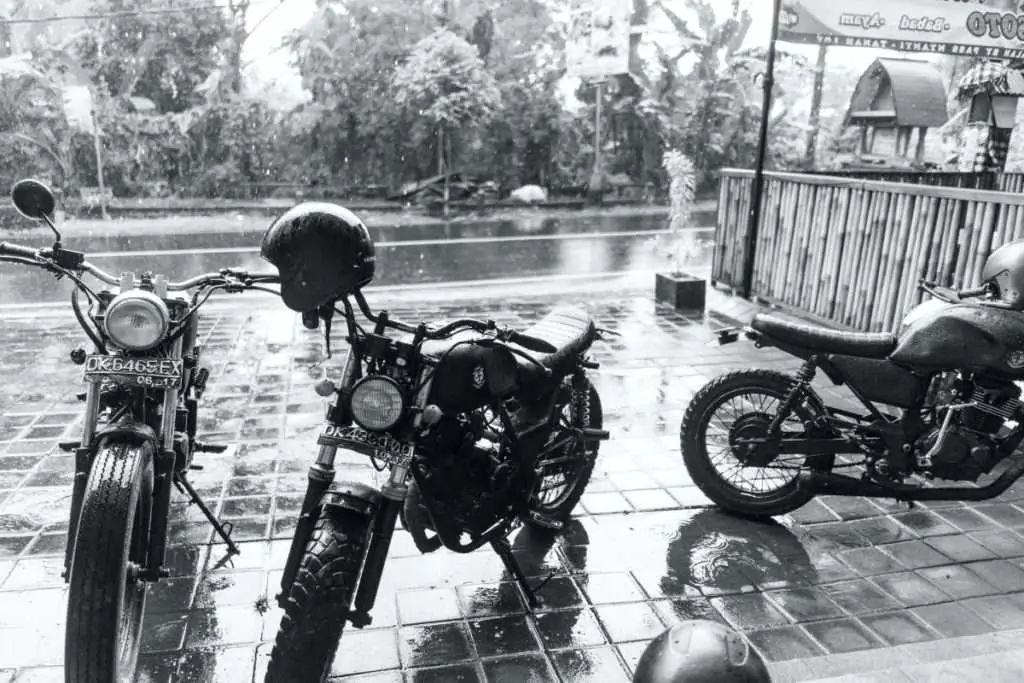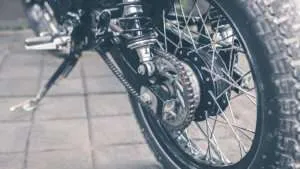Contents
This should be a surprise to none of you: gray skies make it much harder to see.
Not just because they’re gray, but because of what turns them gray.
There are many well-researched articles like this one that tell us about how much harder rain makes it see, due to droplets:
- Making street lamps less bright by blocking part of their light output
- Scattering light rays (meaning less light reflected by objects to your eye; meaning less visibility)
- Droplets on headlamps causing light to “backscatter” and create a glare in your field of vision (makes it much harder on your eyes when telling the contrast between different objects)
- All of these things leaving you with no option other than zeroing-in on the path in front of you- messing with your peripheral vision
And the worst part? Your eyes are going to be taking all of these things in through your helmet visor. With hundreds of water droplets racing downwards on it.
So What Do I Do?

You’re probably fretting over where to start. We get it.
There’s a million articles on the internet and they all contradict each other. But fret no more- because we’ve got you covered.
In this article, we’re going to tell you everything you need to know about handling all the water dripping down your visor while it rains.
What Is A Visor?
Trick question.
Of course you know what a visor is. You’re a smart person.
But using your smarts is easier after you compartmentalize your thoughts.
On that note, a helmet visor:
- Shields your face from dust and tire kickup
- Comes with tints that protect your eyes from all things UV
- Is often loaded with anti-fogging tech to help you see better
And last, but nowhere near least:
- Keeps your pretty face dry when there’s gray in the sky
(Hey, that kind of rhymes.)
There’s a reason we mentioned the last point separately.
Because when it comes to handling your motorcycle in rainy weather, visibility is one of the most important factors.
So you need to know how to handle the moisture build-up on your visor- which the following sections will help you with.
What Should I Do To Help Me See Through My Visor Better When It’s Wet?

Using a mix of one, some, or all of the following is going to make it much easier for you to see through your helmet visor when it gets wet during rains.
Visor Inserts
Visor inserts are made out of material that absorbs moisture, sort of like a sponge.
The inner side is lined with a silicone bead. When attached to your visor, it traps a pocket of air in between.
This pocket of air acts as an insulator to keep the internal temperature in check.
Anti-fogging masks
Anti-fogging masks are exactly what they sound like. They’re masks that you wear to limit the fogging in your helmet.
Fogging happens when your helmet has no airflow to get rid of the moisture inside it. Anti-fogging masks come with “breathers” that direct airflow from your mouth downwards. This makes the moisture from your breath much less likely to end up on the visor.
*They’re also very relevant as of late, considering that the pandemic has given everybody’s mask-wearing muscles a good workout.
Visor Treatments For Water Repellency
When we say visor treatments, we mean anything that helps with your visor vision when it’s wet. But what constitutes “clean your visor” ranges all across the board, which is why you need to remember the following:
- Avoid using sprays with oil in them- they can smear your visor film. Which makes for glare under the sunlight. On the other hand, alcohol-based cleaners evaporate quickly. Which means they do a great job at instantly keeping your visor vision clean.
- As far as cleaning cloths go, microfibre cloth does a fantastic job. But make sure they never fall on the ground (those things are so good at drying that they pick up the tiniest of things- a lot of which aren’t just droplets).
- Applying a “coating” on your visor does a great job of making water less likely to stick. Especially ceramic coatings.
- Keep in mind that a lot of “specialist” visor sprays are as good as your window cleaner- they just happen to be marketed that way to make you pay more.
Finger Visor Wipers
Finger visor wipers are either worn on your finger or your thumb. They were invented to let you wipe wet spots off of your visor mid-riding. They also fit on most riding gloves.
These bad boys are especially helpful in situations where you can’t pull over (such as those involving heavy traffic).
They’re also cheap as hell.
Mistakes To Avoid So That Your Visor Is Primed For Rains

- Common sense, but don’t ride too close to other vehicles on the road. Cause you run a high risk of getting tire kick-ups- and a lot of what gets kicked up is very, disgustingly wet.
- When it’s dusty, keep the visor closed. Dust that gets on the inside of the visor can damage the anti-fog coating. This messes with your visibility when the visor gets wet during a shower.
- When you’re not riding, always store your helmet in a safe place. One that’s cool and dry.
And, please, don’t leave it hanging from your handlebars – unless you’re trying to get rid of it.
Best Products To Help Your Visor Deal With Rain Drops
Rain-X Plastic Water Repellent
Method Of Application: Spray-On
The Rain-X cleaner is a water repellent that uses water beading technology to help you see clearly, even if there are hundreds of droplets dripping down your visor.
- The gold standard for plastic motorcycle visors
- Incredible at water repellency
- Durable coating
Optix 55 Anti-Fog Spray
Method Of Application: Spray-On
Just one second, one spritz, and one wipe- the Optic 55 is an anti-fog spray that clears your visor instantly after being wiped with.
- Hypoallergenic
- Works great on glass and plastic
- Instant action; gets the job done in one spray
Plexus Plastic Cleaner
Method Of Application: Spray-On
Originally used in the aviation industry, the Plexus cleaner does a fantastic job at coating surfaces with thin layers that counter-blocks all things that are both wet and vision-blocking.
- Does a tremendous job at sealing pores in plastic surfaces
- Initially developed for use in aviation
- Design is such that no dripping, leaking, or coagulating happens at the nozzle tip
Aerolon Tech Shine
Method Of Application: Spray-On
Matte, plastic, and vinyl- the Aerolon covers them all. And it covers them all with a coating that turns away anything that has to do H2O.
- The coating formed is extremely hydrophobic
- Less than 2 ounces can fully coat a mid-size car
- Good at wiping rain, mud, sleet, and snow away
P.S. What To Keep In Mind When Your Visor Gets Unexpectedly Wet
If it happens to rain when you’re halfway to your friend’s house and you’re completely unprepared (sigh, Miami), you can make do with soaked toilet paper. Temporarily.
Temporarily.
Just keep in mind to not wipe your visor with the type of toilet paper they store inside the bathroom at your local 7-11. You know, the sandpapery ones. Ugh.




 Ultimate Guide to Types of Motorcycle Helmets
Ultimate Guide to Types of Motorcycle Helmets  How To Clean A Motorcycle Chain | Best Kits Of 2020
How To Clean A Motorcycle Chain | Best Kits Of 2020  Why Your Bike Helmet Looks Huge (and What to Do)
Why Your Bike Helmet Looks Huge (and What to Do)  Sticky And Stinky: How To Clean Motorcycle Helmets
Sticky And Stinky: How To Clean Motorcycle Helmets 